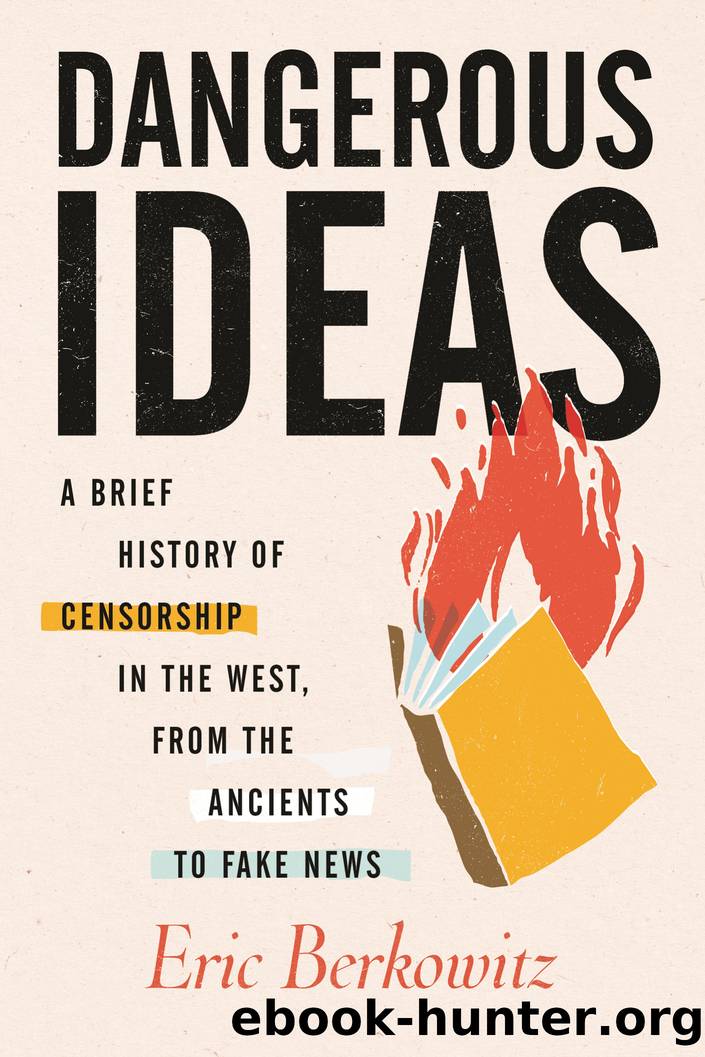Dangerous Ideas by Eric Berkowitz

Author:Eric Berkowitz [Berkowitz, Eric]
Language: eng
Format: epub
Published: 2021-05-15T00:00:00+00:00
Sexual and other moral questions were front and center as censors contended with the advent of cinema and its uniquely powerful effects on audiences. To hype his new Vitascope, Thomas Edison hired two stage actors in 1896 to recreate for the screen the canoodling from the Broadway show The Widow Jones. Edisonâs catalog described the twenty-second film The Kiss this way: âThey get ready to kiss, begin to kiss, and kiss and kiss and kiss in a way that brings down the house every time.â12 As expected, it brought howls of outrage. âSuch things demand police interference,â fumed one critic.13 The criticâs wishes were amply fulfilled, as cinema soon became the definitive mass entertainment. Film censorship was swiftly imposed in the US and Europe. Writing about Germany, the historian Gary Stark describes concerns behind film censorship throughout the West: it âsprang from upper-class fears of the urban lower classes,â as widespread movie consumption was thought to âdeprave and disorientâ them, âundermine their attachment to traditionally sanctioned values, and lead to moral, perhaps even to social, anarchy.â14 On the silver screen, a kiss was not just a kiss.
The first American film censorship rules came out of Chicago in 1907, where more than a hundred thousand people were already visiting nickelodeons every day. Under the cityâs new ordinance, police could bar a film if it was âimmoral or obscene, or portrays depravity, criminality or lack of virtue . . . or tends to produce a breach of the peace, or riots, or purports to represent any hanging, lynching, or burning of a human being.â15 Similar state laws followed, which the US Supreme Court upheld against First Amendment challenges in 1915. The court held that cinema merited no free-speech protections because it was âa business pure and simple,â and films should not âbe regarded as part of the press of the country or as organs of public opinion.â Given that movies were âcapable of evil . . . the greater because of their attractiveness and manner of exhibition,â and were capable of exciting a âprurient interest,â laws preventing such ills were needed.16 That ruling, which stood until 1952, left movies open to a panoply of actual and threatened government controls that the industry would try to avoid by strict self-censorship.
The tendency of early film stock to explode sparked Britainâs first regulations on film content. The 1909 Cinematograph Act empowered localities to impose safety rules on movie theatres, but it was soon used to govern the moral content of what was being shown as well. Faced with the reality of censorship and a confounding array of local standards, members of the film industry formed the British Board of Film Censors (BBFC, much later called the British Board of Film Classification) to impose a âvoluntaryâ scheme of film censorship. No film would be passed unless it was âclean and wholesome and absolutely above suspicion,â a broad standard that covered subcategories for sex, politics, violence, and derogatory representations of the armed forces and the empire.17 However,
Download
This site does not store any files on its server. We only index and link to content provided by other sites. Please contact the content providers to delete copyright contents if any and email us, we'll remove relevant links or contents immediately.
Spell It Out by David Crystal(35826)
Life for Me Ain't Been No Crystal Stair by Susan Sheehan(35519)
Cecilia; Or, Memoirs of an Heiress — Volume 1 by Fanny Burney(32028)
Cecilia; Or, Memoirs of an Heiress — Volume 3 by Fanny Burney(31441)
Cecilia; Or, Memoirs of an Heiress — Volume 2 by Fanny Burney(31389)
The Great Music City by Andrea Baker(30761)
Professional Troublemaker by Luvvie Ajayi Jones(29411)
We're Going to Need More Wine by Gabrielle Union(18611)
Twilight of the Idols With the Antichrist and Ecce Homo by Friedrich Nietzsche(18285)
The Secret History by Donna Tartt(18099)
Cat's cradle by Kurt Vonnegut(14728)
All the Missing Girls by Megan Miranda(14631)
Pimp by Iceberg Slim(13757)
Bombshells: Glamour Girls of a Lifetime by Sullivan Steve(13668)
Fifty Shades Freed by E L James(12892)
Talking to Strangers by Malcolm Gladwell(12829)
Norse Mythology by Gaiman Neil(12795)
The Social Justice Warrior Handbook by Lisa De Pasquale(11945)
Underground: A Human History of the Worlds Beneath Our Feet by Will Hunt(11822)
